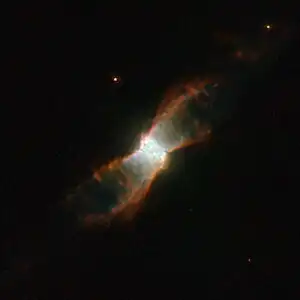| Emission nebula | |
|---|---|
| Planetary nebula | |
 The butterfly-like planetary nebula NGC 6881 is visible here in an image taken by the NASA/ESA Hubble Space Telescope | |
| Observation data: J2000 epoch | |
| Right ascension | 20h 10m 52.45s[1] |
| Declination | +37° 24′ 42.4″[1] |
| Distance | 5200 ± 1600 ly (1600 ± 500[2] pc) |
| Apparent magnitude (V) | 13.700 B [1] |
| Constellation | Cygnus |
| Designations | GSC2 N033220122825, 2MASS J20105244+3724424, PN VV 250, CSI+37-20091, Hen 2-456, PK 074+02 1, PN ARO 108, GCRV 12543, IRAS 20090+3715, PN G074.5+02.1, PN VV' 526 |
NGC 6881 is a planetary nebula, located in the constellation of Cygnus. It is formed of an inner nebula, estimated to be about one fifth of a light-year across, and a symmetrical structure that spreads out about one light-year from one tip to the other. The symmetry could be due to a binary star at the nebula's centre.
References
- 1 2 3 "NGC 6881". SIMBAD. Centre de données astronomiques de Strasbourg. Retrieved 12 March 2012.
- ↑ Guzmán-Ramírez, Lizette; Gómez, Yolanda; Loinard, Laurent; Tafoya, Daniel (2011). "A distance estimate based on angular expansion for the planetary nebula NGC 6881". Monthly Notices of the Royal Astronomical Society. 414 (4): 3129. arXiv:1103.0231. Bibcode:2011MNRAS.414.3129G. doi:10.1111/j.1365-2966.2011.18609.x. S2CID 118695046.
External links
 Media related to NGC 6881 at Wikimedia Commons
Media related to NGC 6881 at Wikimedia Commons
This article is issued from Wikipedia. The text is licensed under Creative Commons - Attribution - Sharealike. Additional terms may apply for the media files.